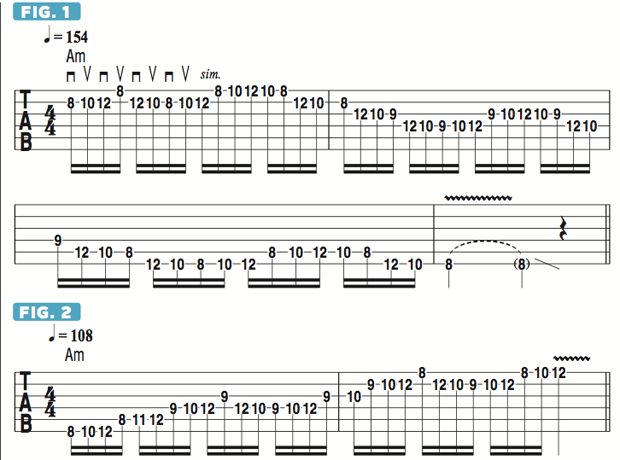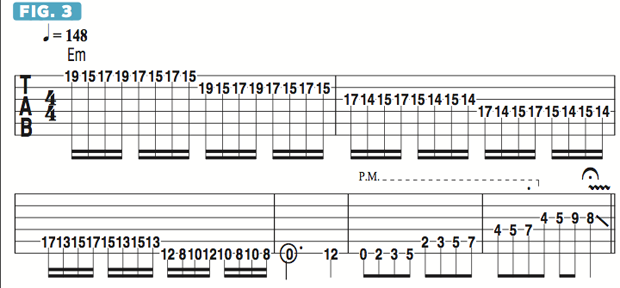How to Reinvent a Modal Melody by Changing Only One Note
Learn a simple, effective way to take any Aeolian line and change and mutate its character.
Most of us are familiar with at least a few of the modes, which are various reorientations of the notes of a standard scale, such as the major scale, around a different root note.
To review, the major scale’s minor modes are Dorian (intervallically spelled 1 2 b3 4 5 6 b7), Aeolian (1 2 b3 4 5 b6 b7), Phrygian (1 b2 b3 4 5 b6 b7), and Locrian (1 b2 b3 4 b5 b6 b7), and its major modes are Ionian, which is the major scale itself (1 2 3 4 5 6 7), Lydian (1 2 3 #4 5 6 7) and Mixolydian (1 2 3 4 5 6 b7). The great majority of metal music is based on the Aeolian mode, and in this month’s column I’d like to show you a simple, effective way to take any Aeolian line and change and mutate its character, which entails altering only one note.

FIGURE 1 is a single-note run based on the A Aeolian mode (A B C D E F G), which is comprised of the same seven notes as the C major scale but rooted on A instead of C. The line is performed with alternate picking (down-up-down-up) throughout, so strive to maintain an even and consistently precise articulation.
The line’s melodic contour begins with four ascending notes, followed by three descending notes, then five ascending notes, and then 11 descending notes, after which the pattern of five ascending notes followed by 11 descending notes repeats.
In FIGURE 2, I use essentially the same structure but move the minor, or “flatted,” seventh, G, up a half step to the major seventh, G#, which mutates the scale to A harmonic minor (A B C D E F G#), intervallically spelled 1 2 b3 4 5 6 7. Using a similar melodic approach, I begin by ascending through one and a half octaves of the scale, followed by a three-note descent and then an eight-note ascent.
Using this pattern, the phrase gradually works its way up the fretboard. Notice how, by simply changing the flatted seventh, G, to the major seventh, G#, the musical character and mood of the line is altered in a very distinct way, illustrating how one can easily substitute one note in any Aeolian melody to transform it into a harmonic-minor melody.

Now let’s try doing this same sort of thing in E minor. The first three bars of FIGURE 3 consist of a long, descending line played in steady 16ths and based on E Aeolian (E F# G A B C D), played in 15th position.
All the latest guitar news, interviews, lessons, reviews, deals and more, direct to your inbox!
In bar 5, I switch to ascending eighth notes based on the same scale, but then, in the next bar, I substitute the major seventh, D#, for the minor, or flatted, seventh, D. The reason this note stands out from the rest is it functions as a brief allusion to the major five chord, B, as D# is that chord’s major third. Try taking any other E Aeolian-based melody you know and changing the D notes to D# to transform it to an E harmonic minor melody.
